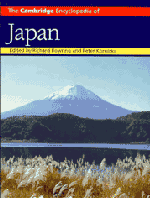
 IN THIS future (I was talking of yesterday) I finally want to see Japan... then all those hours doodling mysterious characters shall finally pay off.
IN THIS future (I was talking of yesterday) I finally want to see Japan... then all those hours doodling mysterious characters shall finally pay off.My Cambridge Encylopedia of Japan, picked up for £2 in a library sale, covers just about everything Japanese. Each section was written by an expert in the field ~ society ~ economy ~ politics ~ arts ~ geography and so on. The history section tells of fascinating encounters with Dutchmen in the 1600s and there are some beautiful landscape photos of Japan's mountainous interior.
The flora and fauna section even gives an oblique mention to Akita and Shiba doggies:
many family dogs are of a breed which has the dense coat and face of a husky...
the furry swines!
The literature section quotes excerpts from a 1987 haiku sequence by 26-year-old schoolteacher Tawara Machi 俵万智 entitled Salad Anniversary. The book was a roaring success, selling 2.6 million in the first five years:
"Call me again" "Wait for me"
Your love is always spoken
in commands
Glancing up at the falling rain
Suddenly I want
your lips
Escape from a shower into a street stall
and drink a glass of cheap saké ~
fun to be alive
The woman at the stall
calls me your wife ~
and so, for a while, I am
The encyclopedia is edited by Richard Bowring, Professor of Japanese at Cambridge, the man who replied to my email asking for titles of the best language textbooks. I was well flattered that a man of such accomplishments should bother with a nobody like me.
 The only work of Japanese literature I've read from cover to cover is The Narrow Road to the Deep North (1702) by Matsuo Bashō 松尾 芭蕉. It is a travel diary illustrated with haiku, which are, in a sense, poetic snapshots.
The only work of Japanese literature I've read from cover to cover is The Narrow Road to the Deep North (1702) by Matsuo Bashō 松尾 芭蕉. It is a travel diary illustrated with haiku, which are, in a sense, poetic snapshots.It's a very Japanese thing to capture the essence of a moment. That's what that scruffy-looking calligraphy in the "grass style" is all about.
When I go to Japan I wnat to take the narrow road to the deep north like Bashō, and see what's there these days.
 To the north of Honshu, the main Japanese island, is the hilly land of HOkkaido, which wasn'tpropely colonized by the Japanese until the late 1800s. The cultivated land has European-stylefields rather than tiered rice paddies like the rest of Japan. The island is known for its special Hokkaido inus. These doggies are a mid-size compromise between the giant Akita-inu and the tiny shiba-inu, which means "brushwood doggie".
To the north of Honshu, the main Japanese island, is the hilly land of HOkkaido, which wasn'tpropely colonized by the Japanese until the late 1800s. The cultivated land has European-stylefields rather than tiered rice paddies like the rest of Japan. The island is known for its special Hokkaido inus. These doggies are a mid-size compromise between the giant Akita-inu and the tiny shiba-inu, which means "brushwood doggie". Sapporo, the capital of Hokkaido island is famous for its extensive underground shopping precincts, built to shelter the Japanese northerners from the Siberian-style snows of midwinter when the tiny shiba-inus have to wear little bumblebee wing-holder-style doggiecoats, despite their bushy fur, so as not to freeze into canine cobwebs.
Talking of furrydoggies, did y'all like my Hachi story? When I first read the story and saw the faithful furry and the kindly professor saying goodbye, and saw how the faithfull furry devotedly waited at the busy railway station hoping against hope for his friend's eventual return, all set to music, I was nearly moved to tears...
Anyway time's nearly up, I gotta go.
HAVE A CHEERY WEEKEND, Y'ALL!
Link: Narrow Road to the Deep North ~ full online text



































5 comments:
My friends have two Akitas, massive beasts they are!
Great post, Gleds and it's great to have a dream. You can get there! But you're not a nobody - you're you! The bit at the end had me crying all over again....
I don't know that I have room really for an Akita. If it was up to me I would keep one, but no pets are allowed in my place and they would really complain about a big dog.
The story of Hachi makes me feel very sad, how the dog refused to give up hope and kept on and on waiting, out in the cold. Today there is even a special Hachiko entrance to Shibuya station in memorial... and a bronze statue in the park commemorating the furry's faithfulness....
I don't usually like haiku but those are good. (Even if they are a translation!)
The best haiku are amazing... but I'm with you in general. "Haiku" can be excuse for the most execrable non-poetry in thankfully brief format ~ ho-h0-hoe!!
Post a Comment